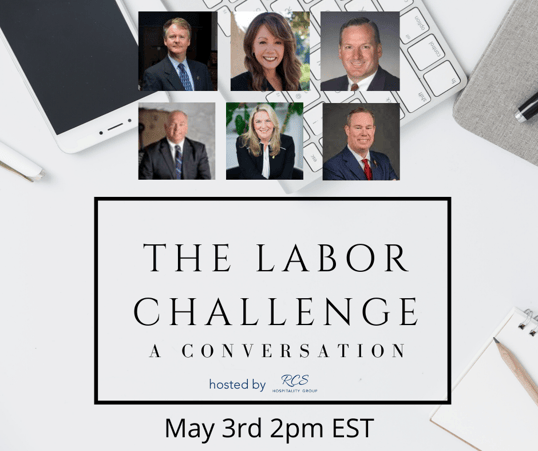Like all employers we are exploring ideas and out of the box thinking to solve the labor crisis we are all facing in our industry.
Please make your labor and scheduling decisions in accordance with your state’s labor laws and/or consult a human resources expert in your area.

Many moons ago--- in 2019, we wrote our predictions for how 2020 would shape the workforce (link to blog post) and while we got some predictions for 2020 right (hello remote work!), for the most part no one could have forecasted how 2020 would change the landscape of our industry… or could they? In 2019 Restaurant Hospitality released an article that got a lot of people talking stating that by 2026 there will be a greater demand for waiters, food servers and cooks than registered nurses. With consideration to what has transpired over the past year, it is safe to say that this prediction may have already come to fruition. As we highlighted last week, the hospitality labor shortage is here to stay thanks to the elimination of nearly 2.5 million jobs and a mass exodus from the industry completely. The biggest contributor to this mass exodus? Presumably the gig economy.
The gig economy; while not a new threat to the hospitality industry, became a serious driving force amidst shutdowns and staff reductions over the past year. What’s not to like about a gig job? If a talented employee can make their own hours, turn work off completely at their leisure, and earn the same amount of money driving for a delivery company such as Door Dash or Uber Eats as they can working in your establishment, what’s the draw for them to work strict hours dictated by someone else? Hopefully as a forward-thinking manager you aren’t getting caught up on and railing against why your talented employees are leaving; rather you are spending time strategizing how to compete to bring talented employees into your organization. Here are a few thoughts:

Scheduling
Transparency is key and your future employees want to know what they are signing up for if they are agreeing to work full time. The hospitality industry is not one that a person goes into for a “traditional Monday-Friday 9-5” schedule, but the employees you seek are ones who ideally want to work their job into their lifestyle rather their lifestyle into their work. Do you still require a minimum number of hours worked to get benefits, or even a preferred schedule? What is your policy on hiring to a schedule (ex: I need someone to work 4pm-close) rather than dictating a schedule that varies? The next generation of employee values flexibility over compensation, and in many cases your organization is likely one of many income streams that they are juggling. How can you adapt to allow shorter shifts and more flexibility? While compensation isn’t the number one factor driving your employees, compensation can’t be ignored completely. Should you adjust pay for certain days and times? If Uber charges more (and pays drivers more) during “Surge” times, can a club take a cue from that model and offer increased training to build skills that allow employees to be paid more during “surge” business times at the club?
Pivot to Part Time
Due to the personalized level of service expected at a club and in hospitality – “where everyone knows your name” – the industry has continued to place priority on full-time employees as their ‘core employee group’ vs part-time employees, who seemingly have a less vested interest in the position or the goals of the facility. Seeking predominantly full-time employees may no longer be a realistic worldview in today’s labor market. As noted above, gig work offers far more flexibility with scheduling versus traditional club work. Gig workers can work as little or as much as they want and work around other life needs such as childcare, homeschooling, a second job, a hobby, or travel. Your line-level workforce will most likely consist of more part-time workers than full-time in the years to come. The number of part-time workers will need to increase in your facility moving forward if you hope to compete in this labor landscape. We cannot hang onto the old business model and methods of doing budgets by looking only at FTE’s (full-time equivalent employees) on a labor spreadsheet.
.png?width=538&name=Untitled%20design%20(34).png)
Interchangeability and Cross Training
Split shifts used to be looked down upon, now they may appeal to those who are attracted to gig work. Let’s take a look at line-level employees—could (and should) your organization feasibly create a schedule in which line-level employees are finished with their shift in the middle of a busy rush and other workers come in towards the end of the rush to finish service and clean the stations? Could you have a set up shift, a service shift, and a clean-up shift? Perhaps an employee would appreciate a split shift for a few hours in the morning and a few in the afternoon or evening, allowing time to pursue other interests, attend school, or spend time with family in between. Staff and shift interchangeability can be achieved through extensive training of new employees, cross training (and cross departmental training) of existing employees, using consistent systems and procedures, and a high-level of communication (link to positive communication info page) amongst your staff. Technology can assist with having consistent processes and increase efficiency. Repetitive and universal tasks are moving to a digital training format. Consider something like including pictures of your stations to allow new employees to visually recognize the location prior to their first time on property. Or use kitchen order boards to reduce errors on the line.
The gig economy is here to stay, and whether you loved or hated Dolly Parton’s Super Bowl commercial, it is an accurate representation of the world in which we live—not everyone is making their money in a conventional fashion, and more often than not they seek flexibility over a traditional work schedule of 6 to 8 hours a day, 5 days per week.
We would be remiss if we didn’t mention; that as we work to keep up with the changing landscape of employment, it’s crucial to pay close attention to any changes to labor laws within your state or locality.

We are having a very valuable exploratory conversation about this subject on May 3rd at 2pm EST and would love you to join us.









